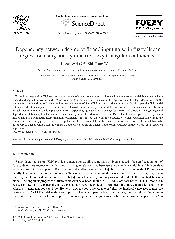摘要
Fuzzy linear regression (FLR) model can be thought of as a fuzzy variation of classical linear regression model. It has been widely studied and applied in diverse fields. When noise exists in data, it is a very meaningful topic to reveal the dependency between the parameter h (i.e. the threshold value used to measure degree of fit) in FLR model and the input noise. In this paper, the FLR model is first extended to its regularized version, i.e. regularized fuzzy linear regression (RFLR) model, so as to enhance its generalization capability; then RFLR model is explained as the corresponding equivalent maximum a posteriori (MAP) problem; finally, the general dependency relationship that the parameter h with noisy input should follow is derived. Particular attention is paid to the regression model using non-symmetric fuzzy triangular coefficients. It turns out that with the existence of typical Gaussian noisy input, the parameter h is inversely proportional to the input noise. Our experimental results here also confirm this theoretical claim. Obviously, this theoretical result will be helpful to make a good choice for the parameter h, and to apply FLR techniques effectively in practical applications.
- 出版日期2007-10-1
- 单位江南大学
